warning BMW M3 COUPE 2004 E46 Owner's Manual
[x] Cancel search | Manufacturer: BMW, Model Year: 2004, Model line: M3 COUPE, Model: BMW M3 COUPE 2004 E46Pages: 170, PDF Size: 2.62 MB
Page 8 of 170
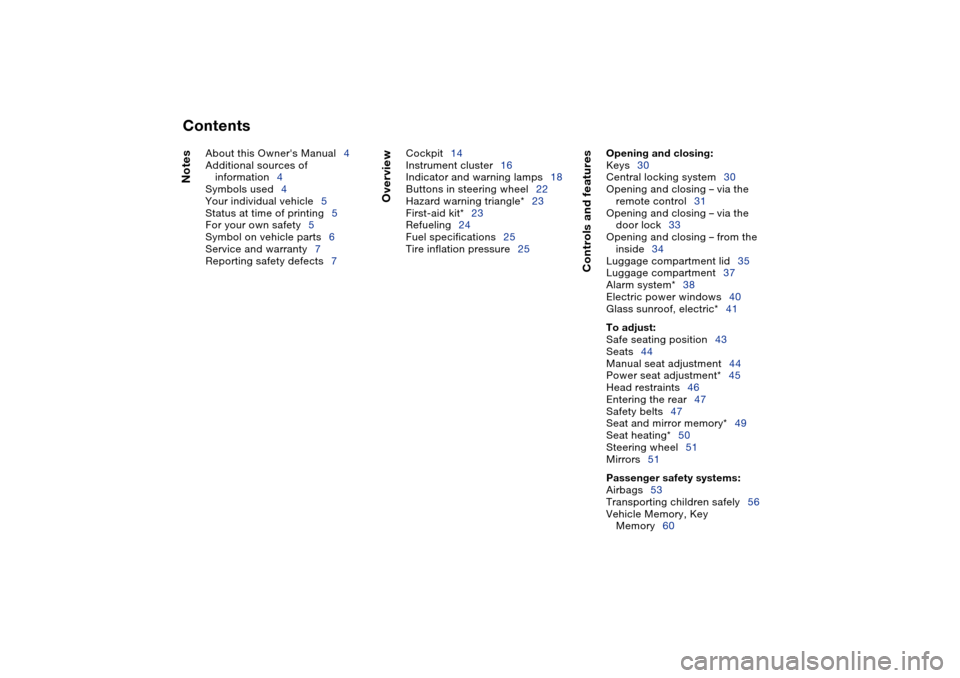
Contents
Notes
About this Owner's Manual4
Additional sources of
information4
Symbols used4
Your individual vehicle5
Status at time of printing5
For your own safety5
Symbol on vehicle parts6
Service and warranty7
Reporting safety defects7
Overview
Cockpit14
Instrument cluster16
Indicator and warning lamps18
Buttons in steering wheel22
Hazard warning triangle*23
First-aid kit*23
Refueling24
Fuel specifications25
Tire inflation pressure25
Controls and features
Opening and closing:
Keys30
Central locking system30
Opening and closing – via the
remote control31
Opening and closing – via the
door lock33
Opening and closing – from the
inside34
Luggage compartment lid35
Luggage compartment37
Alarm system*38
Electric power windows40
Glass sunroof, electric*41
To adjust:
Safe seating position43
Seats44
Manual seat adjustment44
Power seat adjustment*45
Head restraints46
Entering the rear47
Safety belts47
Seat and mirror memory*49
Seat heating*50
Steering wheel51
Mirrors51
Passenger safety systems:
Airbags53
Transporting children safely56
Vehicle Memory, Key
Memory60
Page 10 of 170
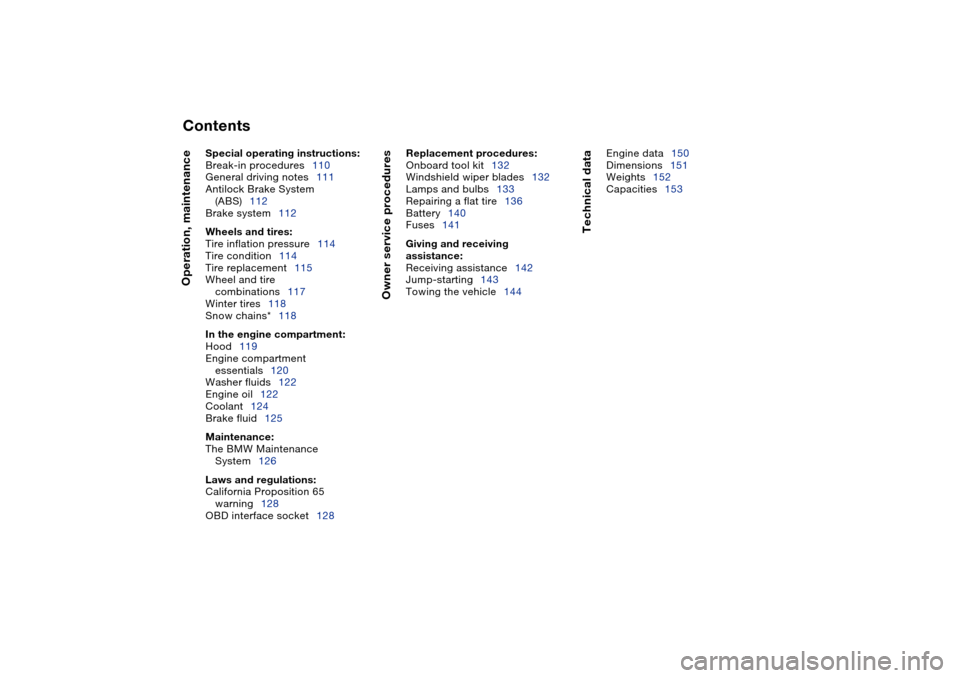
Contents
Operation, maintenance
Special operating instructions:
Break-in procedures110
General driving notes111
Antilock Brake System
(ABS)112
Brake system112
Wheels and tires:
Tire inflation pressure114
Tire condition114
Tire replacement115
Wheel and tire
combinations117
Winter tires118
Snow chains*118
In the engine compartment:
Hood119
Engine compartment
essentials120
Washer fluids122
Engine oil122
Coolant124
Brake fluid125
Maintenance:
The BMW Maintenance
System126
Laws and regulations:
California Proposition 65
warning128
OBD interface socket128
Owner service procedures Replacement procedures: Onboard tool kit132
Windshield wiper blades132
Lamps and bulbs133
Repairing a flat tire136
Battery140
Fuses141 Giving and receiving
assistance: Receiving assistance142
Jump-starting143
Towing the vehicle144
Technical data
Engine data150
Dimensions151
Weights152
Capacities153
Page 15 of 170
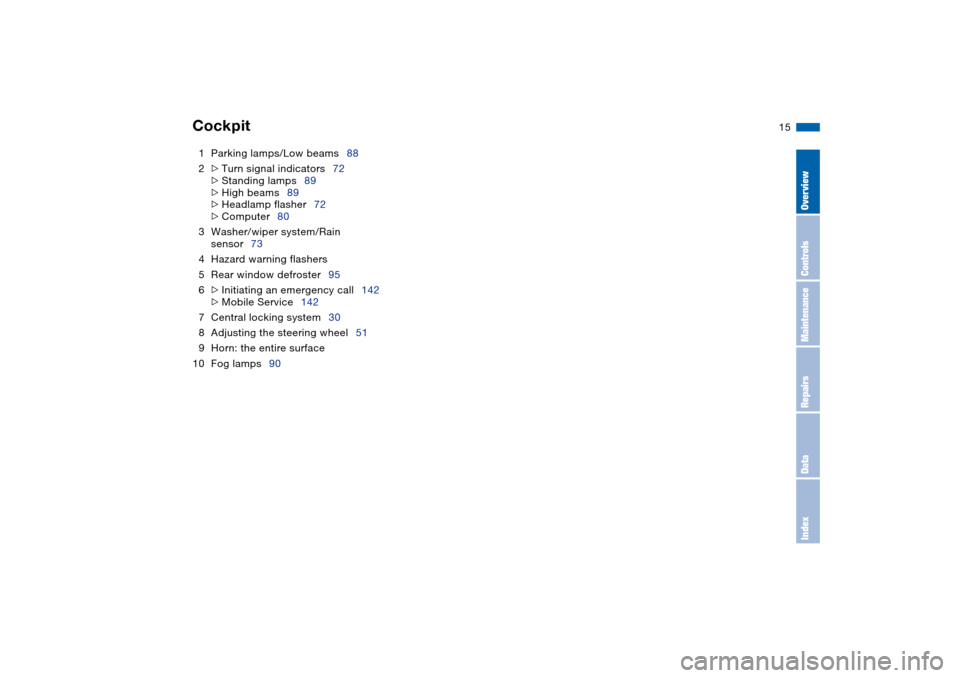
15
1Parking lamps/Low beams88
2
>
Turn signal indicators72
>
Standing lamps89
>
High beams89
>
Headlamp flasher72
>
Computer80
3Washer/wiper system/Rain
sensor73
4Hazard warning flashers
5Rear window defroster95
6
>
Initiating an emergency call142
>
Mobile Service142
7Central locking system30
8Adjusting the steering wheel51
9Horn: the entire surface
10 Fog lamps90
Cockpit
OverviewControlsMaintenanceRepairsDataIndex
Page 17 of 170
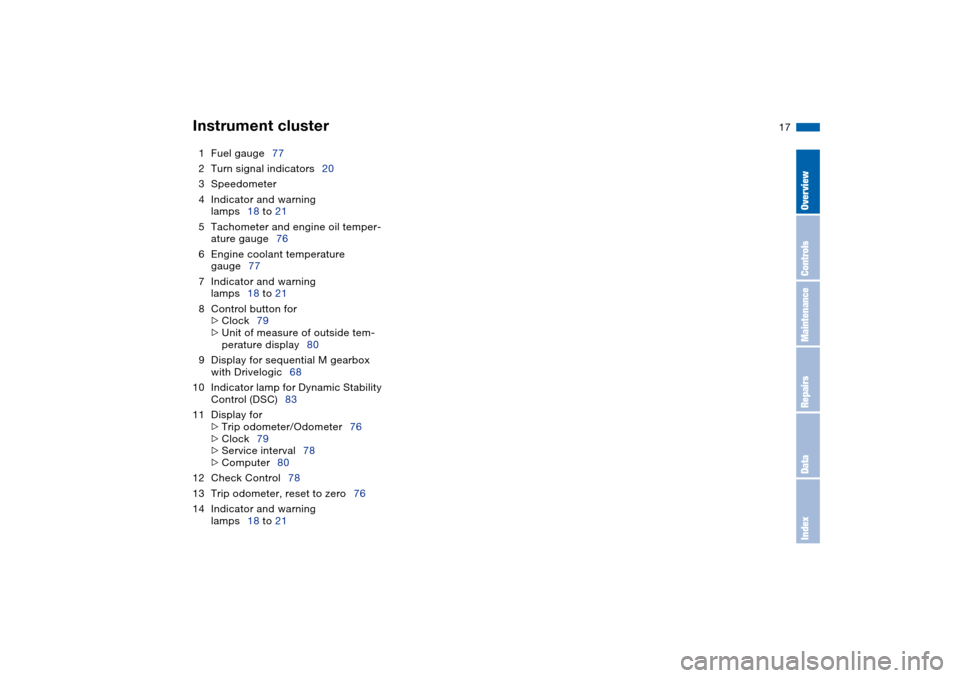
17
1Fuel gauge77
2Turn signal indicators20
3Speedometer
4Indicator and warning
lamps18 to 21
5Tachometer and engine oil temper-
ature gauge76
6Engine coolant temperature
gauge77
7Indicator and warning
lamps18 to 21
8Control button for
>
Clock79
>
Unit of measure of outside tem-
perature display80
9Display for sequential M gearbox
with Drivelogic68
10 Indicator lamp for Dynamic Stability
Control (DSC)83
11 Display for
>
Trip odometer/Odometer76
>
Clock79
>
Service interval78
>
Computer80
12 Check Control78
13 Trip odometer, reset to zero76
14 Indicator and warning
lamps18 to 21
Instrument cluster
OverviewControlsMaintenanceRepairsDataIndex
Page 18 of 170
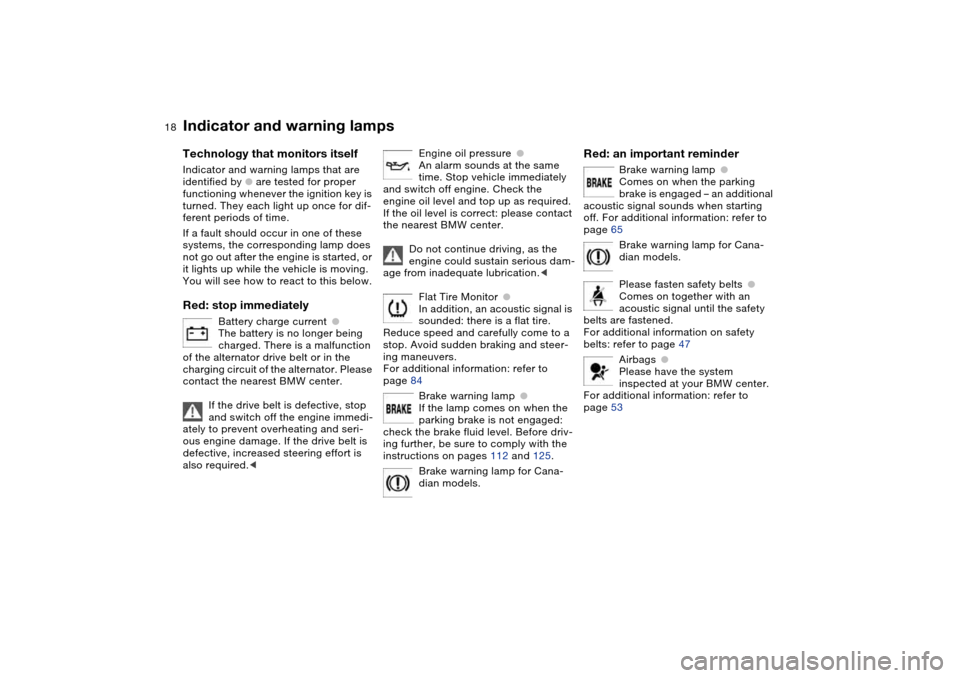
18
Indicator and warning lamps
Technology that monitors itself
Indicator and warning lamps that are
identified by
●
are tested for proper
functioning whenever the ignition key is
turned. They each light up once for dif-
ferent periods of time.
If a fault should occur in one of these
systems, the corresponding lamp does
not go out after the engine is started, or
it lights up while the vehicle is moving.
You will see how to react to this below.
Red: stop immediately
Battery charge current
●
The battery is no longer being
charged. There is a malfunction
of the alternator drive belt or in the
charging circuit of the alternator. Please
contact the nearest BMW center.
If the drive belt is defective, stop
and switch off the engine immedi-
ately to prevent overheating and seri-
ous engine damage. If the drive belt is
defective, increased steering effort is
also required.
<
Engine oil pressure
●
An alarm sounds at the same
time. Stop vehicle immediately
and switch off engine. Check the
engine oil level and top up as required.
If the oil level is correct: please contact
the nearest BMW center.
Do not continue driving, as the
engine could sustain serious dam-
age from inadequate lubrication.
<
Flat Tire Monitor
●
In addition, an acoustic signal is
sounded: there is a flat tire.
Reduce speed and carefully come to a
stop. Avoid sudden braking and steer-
ing maneuvers.
For additional information: refer to
page 84
Brake warning lamp
●
If the lamp comes on when the
parking brake is not engaged:
check the brake fluid level. Before driv-
ing further, be sure to comply with the
instructions on pages 112 and 125.
Brake warning lamp for Cana-
dian models.
Red: an important reminder
Brake warning lamp
●
Comes on when the parking
brake is engaged – an additional
acoustic signal sounds when starting
off. For additional information: refer to
page 65
Brake warning lamp for Cana-
dian models.
Please fasten safety belts
●
Comes on together with an
acoustic signal until the safety
belts are fastened.
For additional information on safety
belts: refer to page 47
Airbags
●
Please have the system
inspected at your BMW center.
For additional information: refer to
page 53
Page 19 of 170
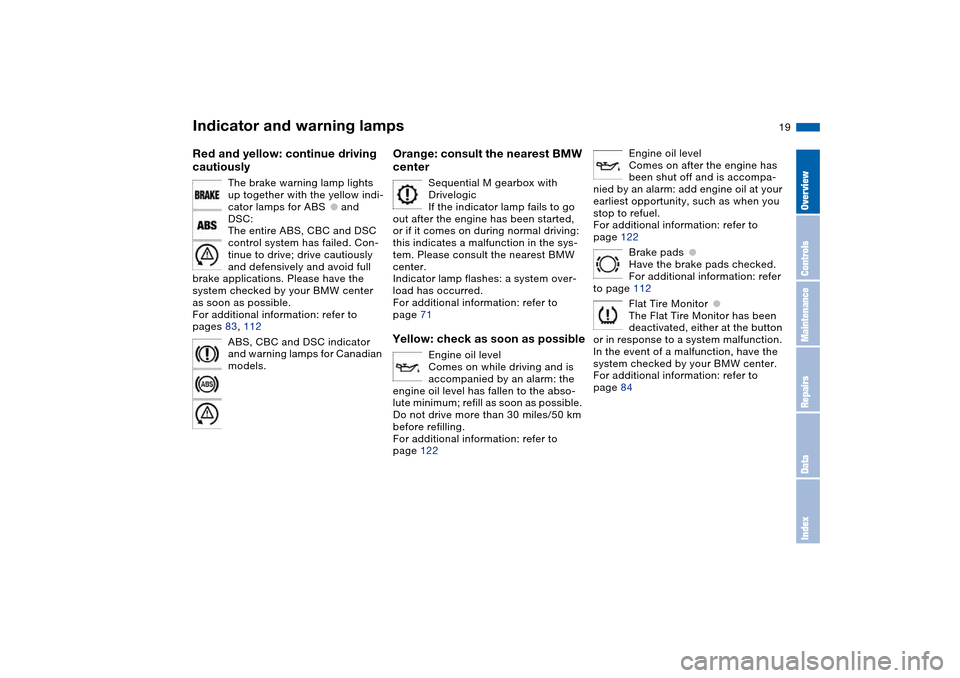
19
Red and yellow: continue driving
cautiously
The brake warning lamp lights
up together with the yellow indi-
cator lamps for ABS
●
and
DSC:
The entire ABS, CBC and DSC
control system has failed. Con-
tinue to drive; drive cautiously
and defensively and avoid full
brake applications. Please have the
system checked by your BMW center
as soon as possible.
For additional information: refer to
pages 83, 112
ABS, CBC and DSC indicator
and warning lamps for Canadian
models.
Orange: consult the nearest BMW
center
Sequential M gearbox with
Drivelogic
If the indicator lamp fails to go
out after the engine has been started,
or if it comes on during normal driving:
this indicates a malfunction in the sys-
tem. Please consult the nearest BMW
center.
Indicator lamp flashes: a system over-
load has occurred.
For additional information: refer to
page 71
Yellow: check as soon as possible
Engine oil level
Comes on while driving and is
accompanied by an alarm: the
engine oil level has fallen to the abso-
lute minimum; refill as soon as possible.
Do not drive more than 30 miles/50 km
before refilling.
For additional information: refer to
page 122
Engine oil level
Comes on after the engine has
been shut off and is accompa-
nied by an alarm: add engine oil at your
earliest opportunity, such as when you
stop to refuel.
For additional information: refer to
page 122
Brake pads
●
Have the brake pads checked.
For additional information: refer
to page 112
Flat Tire Monitor
●
The Flat Tire Monitor has been
deactivated, either at the button
or in response to a system malfunction.
In the event of a malfunction, have the
system checked by your BMW center.
For additional information: refer to
page 84
Indicator and warning lamps
OverviewControlsMaintenanceRepairsDataIndex
Page 20 of 170
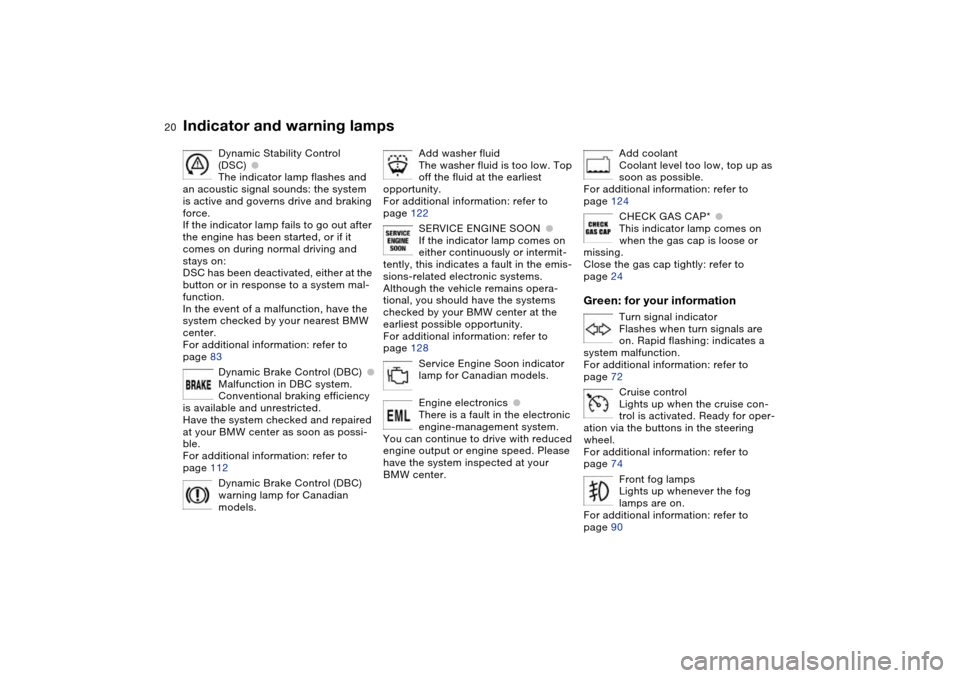
20
Dynamic Stability Control
(DSC)
●
The indicator lamp flashes and
an acoustic signal sounds: the system
is active and governs drive and braking
force.
If the indicator lamp fails to go out after
the engine has been started, or if it
comes on during normal driving and
stays on:
DSC has been deactivated, either at the
button or in response to a system mal-
function.
In the event of a malfunction, have the
system checked by your nearest BMW
center.
For additional information: refer to
page 83
Dynamic Brake Control (DBC)
●
Malfunction in DBC system.
Conventional braking efficiency
is available and unrestricted.
Have the system checked and repaired
at your BMW center as soon as possi-
ble.
For additional information: refer to
page 112
Dynamic Brake Control (DBC)
warning lamp for Canadian
models.
Add washer fluid
The washer fluid is too low. Top
off the fluid at the earliest
opportunity.
For additional information: refer to
page 122
SERVICE ENGINE SOON
●
If the indicator lamp comes on
either continuously or intermit-
tently, this indicates a fault in the emis-
sions-related electronic systems.
Although the vehicle remains opera-
tional, you should have the systems
checked by your BMW center at the
earliest possible opportunity.
For additional information: refer to
page 128
Service Engine Soon indicator
lamp for Canadian models.
Engine electronics
●
There is a fault in the electronic
engine-management system.
You can continue to drive with reduced
engine output or engine speed. Please
have the system inspected at your
BMW center.
Add coolant
Coolant level too low, top up as
soon as possible.
For additional information: refer to
page 124
CHECK GAS CAP*
●
This indicator lamp comes on
when the gas cap is loose or
missing.
Close the gas cap tightly: refer to
page 24
Green: for your information
Turn signal indicator
Flashes when turn signals are
on. Rapid flashing: indicates a
system malfunction.
For additional information: refer to
page 72
Cruise control
Lights up when the cruise con-
trol is activated. Ready for oper-
ation via the buttons in the steering
wheel.
For additional information: refer to
page 74
Front fog lamps
Lights up whenever the fog
lamps are on.
For additional information: refer to
page 90
Indicator and warning lamps
Page 21 of 170
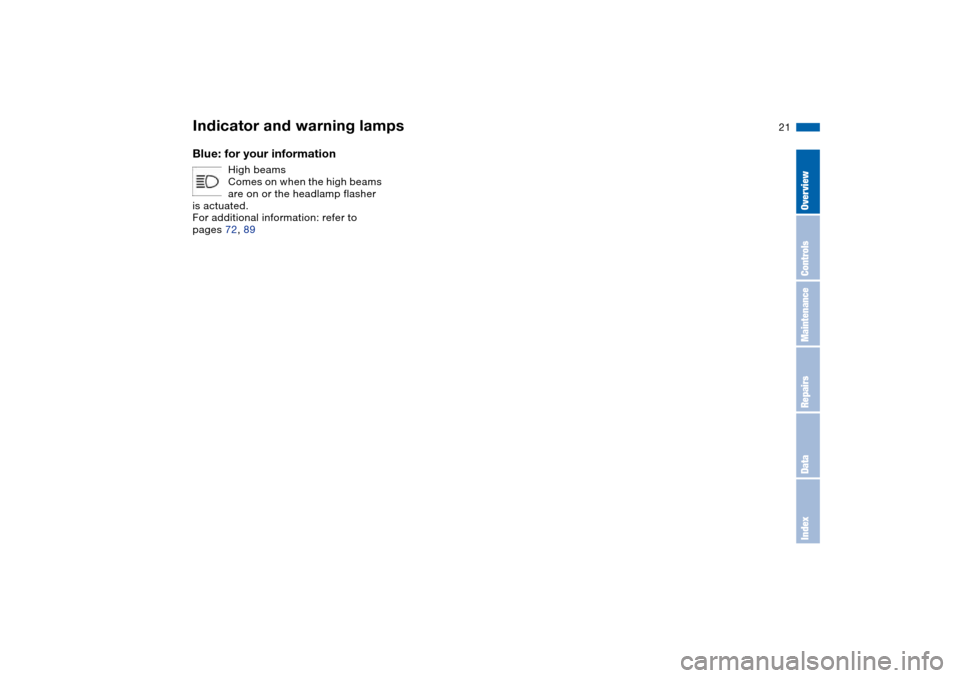
21
Blue: for your information
High beams
Comes on when the high beams
are on or the headlamp flasher
is actuated.
For additional information: refer to
pages 72, 89
Indicator and warning lamps
OverviewControlsMaintenanceRepairsDataIndex
Page 23 of 170
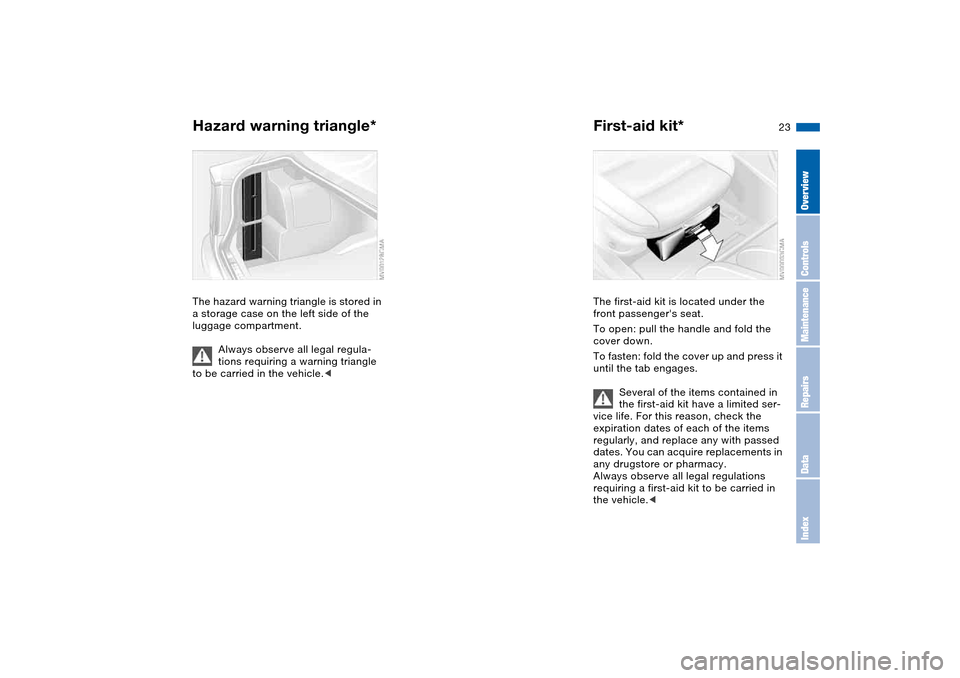
23
Hazard warning triangle*The hazard warning triangle is stored in
a storage case on the left side of the
luggage compartment.
Always observe all legal regula-
tions requiring a warning triangle
to be carried in the vehicle.<
First-aid kit*The first-aid kit is located under the
front passenger's seat.
To open: pull the handle and fold the
cover down.
To fasten: fold the cover up and press it
until the tab engages.
Several of the items contained in
the first-aid kit have a limited ser-
vice life. For this reason, check the
expiration dates of each of the items
regularly, and replace any with passed
dates. You can acquire replacements in
any drugstore or pharmacy.
Always observe all legal regulations
requiring a first-aid kit to be carried in
the vehicle.<
OverviewControlsMaintenanceRepairsDataIndex
Page 30 of 170
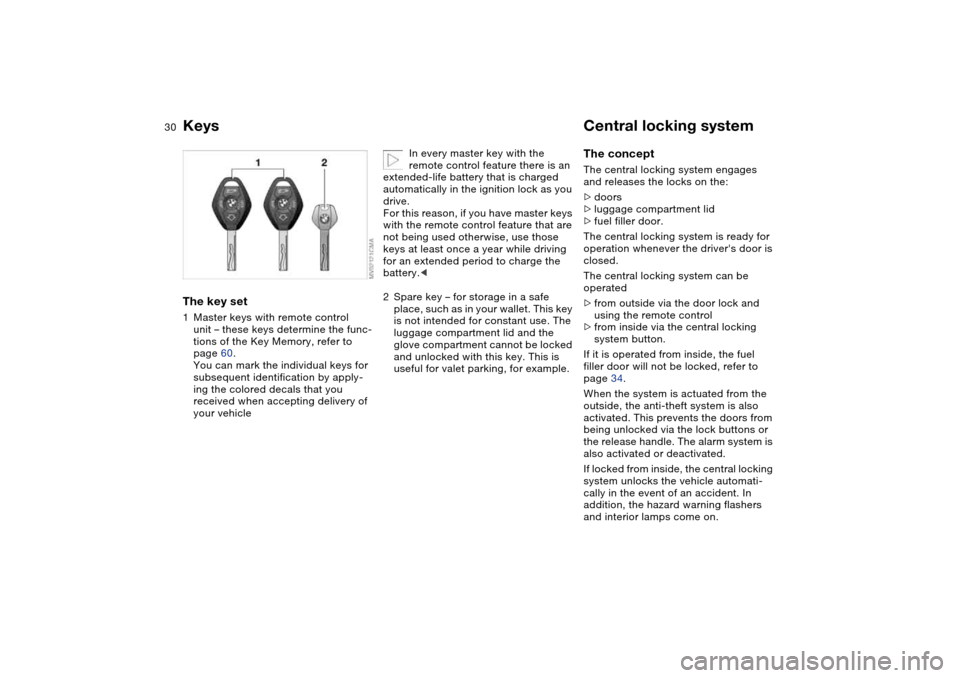
30Opening and closing
KeysThe key set1Master keys with remote control
unit – these keys determine the func-
tions of the Key Memory, refer to
page 60.
You can mark the individual keys for
subsequent identification by apply-
ing the colored decals that you
received when accepting delivery of
your vehicle
In every master key with the
remote control feature there is an
extended-life battery that is charged
automatically in the ignition lock as you
drive.
For this reason, if you have master keys
with the remote control feature that are
not being used otherwise, use those
keys at least once a year while driving
for an extended period to charge the
battery.<
2Spare key – for storage in a safe
place, such as in your wallet. This key
is not intended for constant use. The
luggage compartment lid and the
glove compartment cannot be locked
and unlocked with this key. This is
useful for valet parking, for example.
Central locking systemThe conceptThe central locking system engages
and releases the locks on the:
>doors
>luggage compartment lid
>fuel filler door.
The central locking system is ready for
operation whenever the driver's door is
closed.
The central locking system can be
operated
>from outside via the door lock and
using the remote control
>from inside via the central locking
system button.
If it is operated from inside, the fuel
filler door will not be locked, refer to
page 34.
When the system is actuated from the
outside, the anti-theft system is also
activated. This prevents the doors from
being unlocked via the lock buttons or
the release handle. The alarm system is
also activated or deactivated.
If locked from inside, the central locking
system unlocks the vehicle automati-
cally in the event of an accident. In
addition, the hazard warning flashers
and interior lamps come on.